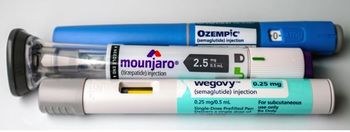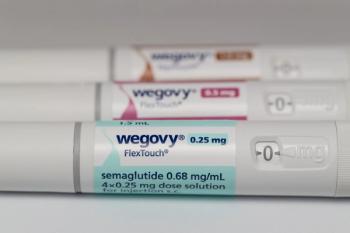
Psoas Abscess
A 49-year-old woman with a history of alcoholic cirrhosis, esophageal varices, coronary artery disease, diabetes mellitus, and hypertension presented to the emergency department with a 2-day history of fever, chills, nausea, and back and abdominal pain. The pain began on the right side, progressed to the lower back, and radiated into the right anterior thigh and groin area.
A 49-year-old woman with a history of alcoholic cirrhosis, esophageal varices, coronary artery disease, diabetes mellitus, and hypertension presented to the emergency department with a 2-day history of fever, chills, nausea, and back and abdominal pain. The pain began on the right side, progressed to the lower back, and radiated into the right anterior thigh and groin area.
The patient's temperature was 38.6°C (101.5°F); heart rate, 87 beats per minute; respiration rate, 20 breaths per minute; and blood pressure, 124/74 mm Hg. Head, ears, eyes, nose, and throat findings were within normal limits. Neck examination revealed no adenopathy, bruits, or jugular venous distension. Cardiac findings included a holosystolic murmur, grade III/IV, which radiated to the left axilla. The lungs were clear; a chest film was negative. Neurologic findings were normal.
Abdominal examination revealed right lower quadrant tenderness, positive bowel sounds, and a positive psoas sign. No rectal masses were found. Hemoccult results were negative.
Laboratory values were sodium, 124 mmol/L; chloride, 88 mmol/L; potassium, 3.9 mmol/L; bicarbonate, 22 mmol/L; blood urea nitrogen, 21 mg/dL; and creatinine, 0.8 mg/dL. The anion gap was 14 mmol/L; glucose, 393 mg/dL; total serum protein, 7.9 g/dL; albumin, 2.7 g/dL; total bilirubin, 3.3 mg/dL; alkaline phosphatase, 270 U/L; aspartate aminotransferase, 22 U/L; alanine aminotransferase, 15 U/L; γ-glutamyltransferase, 148 U/L; amylase, 35 U/L; and lipase, 15 U/L. White blood cell (WBC) count was 11,340/mL (60% neutrophils, 18% bands); hemoglobin, 10 g/dL; hematocrit, 28.9%; platelets, 122,000/mL; prothrombin time, 12.1 seconds; and partial thromboplastin time, 25.1 seconds. Urinalysis revealed 1+ protein, 3+ glucose, 1+ leukocyte esterase, and 5 to 19 WBCs.
An ultrasound scan of the right kidney demonstrated a 9.3- × 5.2- 3 6.6-cm mass arising from the posterior surface of the organ. CT scan of the abdomen showed a 7- × 5-cm mass displacing the kidney. This finding suggested the presence of a psoas abscess. The mass was aspirated under ultrasound guidance; a culture grew Staphylococcus aureus. The culture confirmed the suspected diagnosis of psoas abscess.
Drs Mark Franco and Carol Woody and Steve Moye of Greenville, NC, write that psoas abscesses are rare; only a few cases are reported each year.1 Primary abscesses occur without a definite predisposing disease etiology. The causative organisms are usually S aureus (88%), streptococcus (5%), and Escherichia coli (3%). Secondary abscesses usually arise from known disease processes such as tuberculosis, osteomyelitis, and inflammatory bowel disease. Diagnosis generally is made by ultrasonography or CT. Treatment includes surgical drainage of the psoas abscess and broad-spectrum antibiotic therapy. This patient received ceftriaxone for 4 days; the aspirate was sensitive to cephalosporin. After discharge from the hospital, she took cefadroxil for 4 weeks. A subsequent CT scan showed that the abscess had completely resolved. Recurrences of this condition are rare.
REFERENCE:1. Maradiaga GM, Fiorilli MG, Elmore WG, Hunt J. Psoas abscess: diagnosed if suspected. N C Med J. 1998;59:54-56.
Newsletter
Enhance your clinical practice with the Patient Care newsletter, offering the latest evidence-based guidelines, diagnostic insights, and treatment strategies for primary care physicians.































































































































































































































































































